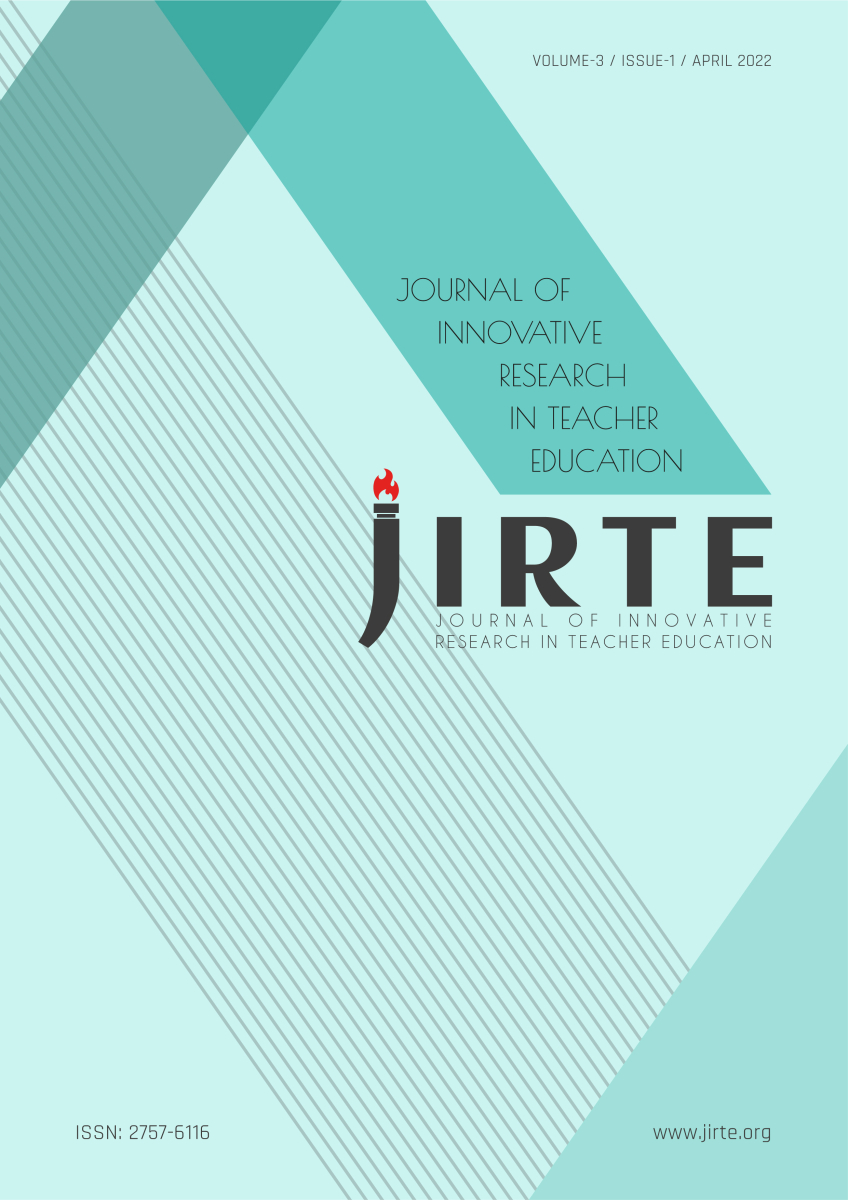Research article | Open Access
Journal of Innovative Research in Teacher Education 2021, Vol. 2(3) 181-192
The Metaphors of Teacher Candidates on Distance Learning
pp. 181 - 192 | DOI: https://doi.org/10.29329/jirte.2021.408.1
Publish Date: December 23, 2021 | Single/Total View: 191/962 | Single/Total Download: 293/1.945
Abstract
This study aims to determine the metaphoric perceptions of candidate teachers of special education and candidate teachers of other departments on distance education. The phenemology pattern, which is a qualitative research method, was used for the study. The study group consists of 150 candidate teachers of special education and 150 candidate teachers of other departments, which is a total of 300 teacher candidates. The data of the research was collected using Google forms. In order to collect data for the study, the teacher candidates participating in the study were asked to complete the following sentences:‘Distance education is like ……………. because ………….' The content analysis technique was used for analysing the data obtained. As a result of the analysis made, the metaphors created by teacher candidates in both groups on distance education were studied under different categories such as ‘living things-non living things, abstract-concrete metaphors, entertainment and needs'. The data obtained in the study reveals that candidate teachers of special education and candidate teachers of other departments have negative metaphors concerning distance learning, and they have created metaphors such as cold tea, homesickness, effort in vain and sin for distance education.
Keywords: distance learning, teacher candidates, special education, other departments, metaphors.
APA 7th edition
Pursun, T., Yapar, B., Arslantas, S., & Taskesen, U.S. (2021). The Metaphors of Teacher Candidates on Distance Learning. Journal of Innovative Research in Teacher Education, 2(3), 181-192. https://doi.org/10.29329/jirte.2021.408.1
Harvard
Pursun, T., Yapar, B., Arslantas, S. and Taskesen, U. (2021). The Metaphors of Teacher Candidates on Distance Learning. Journal of Innovative Research in Teacher Education, 2(3), pp. 181-192.
Chicago 16th edition
Pursun, Tugba, Burcu Yapar, Suleyman Arslantas and Umit Savas Taskesen (2021). "The Metaphors of Teacher Candidates on Distance Learning". Journal of Innovative Research in Teacher Education 2 (3):181-192. https://doi.org/10.29329/jirte.2021.408.1
Allen, I. E., & Seaman, J. (2011). Going the distance: Online education in the United States. The online learning consortium. Retrieved from http://sloanconsortium. org/publications/survey/going_distance_2011.
Bağrıaçık-Yılmaz, A. (2018). Distance and face-to-face students perceptions towards distance education: a comparative metaphorical study. Turkish Online Journal of Distance Education, 20(1), 191-207.
Bernat, F., & Frailing, K. (2015). Perfecting lessons learned for criminal justice online graduate education: Reflection, integration, and application. Journal of Criminal Justice Education, 26(3), 330-353.
Bozdağ, B., & Dinç, F. (2020). The perceptions of physical education teacher candidates towards the concept of distance education in the covid-19 process: A Metaphor study. International Journal of Eurasian Education and Culture, 11, 1954-1980.
Ceylan, A. (2016). Determining the metaphorical perceptions of the concept of family. Unpublished master thesis, Sakarya University, Sakarya.
Creswell, J. W. (2020). Nitel araştırma yöntemleri: Beş yaklaşıma göre nitel araştırma ve araştırma deseni, (Çev. Ed: Bütün, M. & Demir, S.B.). Siyasal Kitabevi.
Holly, C. (2009). The case for distance education in nursing. MERLOT Journal of Online Learning and Teaching, 5(3), 506-510.
Horzum, M. B. (2003). Opinions of lecturers on internet-supported education (Sakarya University example). Unpublished master thesis, Sakarya University, Sakarya.
Kaleli-Yılmaz, G., & Güven, B. (2015). Determining the teacher candidates perceptions on distance education by metaphors. Turkish Journal of Computer and Mathematics Education, 6(2), 299-322.
Karatas, S., Yilmaz, Bagriacik, A., Dikmen, C. H., Ermis, U. F., & Gürbüz, O. (2017). Interaction in distance education environments: A trend analysis. Quarterly Review of Distance Education, 18(1), 3-82.
Kleiman, S. (2004). Phenomenology: To wonder and search for meanings. Nurse Researcher, 11(4), 7-19.
Korkmaz, F. & Ünsal, S. (2016). Examining the metaphorical perceptions of preschool teachers about the concept of technology. Mustafa Kemal University Journal of Graduate School of Social Sciences, 13(35), 194-21.
Lenka, S. K., & Kant, R. (2012). A study of attitude and perception of the learners towards distance education in relation to their biographical factors. Turkish Online Journal of Distance Education, 13(4), 236-244.
Mehrotra, C. M., Hollister, C. D., & McGahey, L. (2001). Distance learning: Principles for effective design, delivery, and evaluation. Thousand Oaks, CA: Sage Publications, Inc.
Patton, M. Q. (1990). Qualitative evaluation and research methods. USA: Sage.
Patton, M. Q. (2014). Qualitative research & evaluation methods integrating theory and practice. Sage Publications.
Saban, A. (2009). Mental images of candidate teachers regarding the concept of students. Turkish Journal of Educational Sciences, 7(2), 281-326.
Saban, A. (2010). Prospective teachers’ metaphorical conceptualizations of learner. Teaching and Teacher Education, 26(2), 290-305.
Saban, A., Koçbeker, B. N., & Saban, A. (2006). Examination of candidate teachers' perceptions of the concept of teacher through metaphor analysis. Educational Sciences in Theory and Practice, 6(2), 461-522.
Seggie, F. N., & Bayyurt, Y. (2015). Qualitative research: Methods, techniques, analysis and approaches Ankara: Anı.
Shaw, D. M., & Mahlios, M. (2011). Literacy metaphors of pre-service teachers: Do they change after instruction? Which metaphors are stable? How do they connect to theories? Journal of Education for Teaching, 37(1), 77- 92.
Shelton, K., & Saltsman, G. (2005). An administrator’s guide to online education. Greenwich, CT: Information Age Publishing.
Taş, H., Yavuzalp, N., & Gürer, M. (2016). Determining the perceptions of computer education and instructional technology department students towards distance education through metaphors. 4th International Instructional Technologies & Teacher Education Symposium, Elazig, Turkey.
Tirzui, A-M.. & Vrabie, C. (2014). Education 2.0: E-learning methods. Procedia – Social and Behavioral Sciences, 186, 376-380.
Tompkins, P., & Lawley, J. (2002). The magic of metaphor. The Caroline Newsletter.
Toven-Lindsey, B., Rhoads, R. A., & Lozano, J. B. (2015). Virtually unlimited classrooms: Pedagogical practices in massive open online courses. The internet and higher education, 24, 1-12.
Tuncay, N., & Özçinar, Z. (2009). Distance education students’ metaphors. Procedia-Social and Behavioral Sciences, 1(1), 2883-2888.
Uşun, S. (2006). Distance learning. Ankara: Nobel.
Yalın, H. İ. (2007). Instructional technologies and material development. Ankara: Nobel.
Yıldırım, H., & Şimşek, A. (2016). Qualitative research methods in the social sciences. Ankara: Seçkin.
Yurdakul, B. (2005). Distance learning. Ö. Demirel (Ed.). New Directions in Education. Ankara: Pegem.
